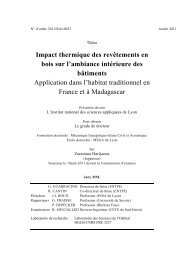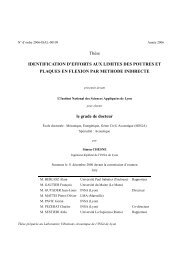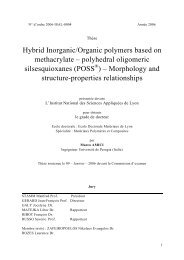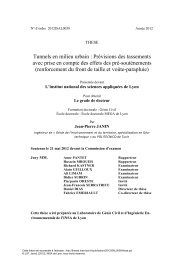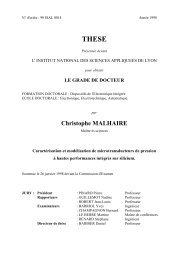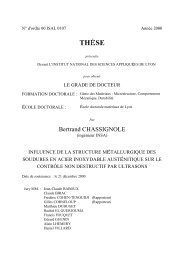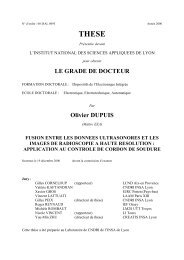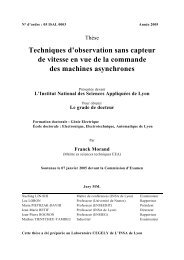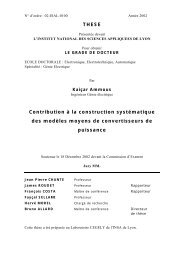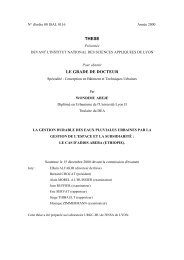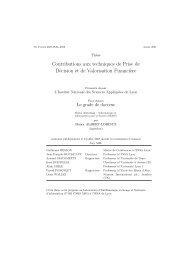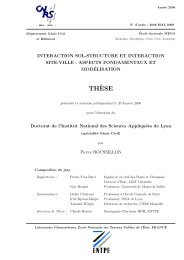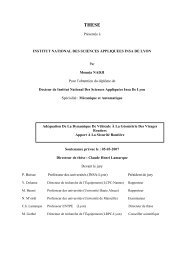Traitement et analyse de séries chronologiques continues de ...
Traitement et analyse de séries chronologiques continues de ...
Traitement et analyse de séries chronologiques continues de ...
Create successful ePaper yourself
Turn your PDF publications into a flip-book with our unique Google optimized e-Paper software.
Annexes<br />
M M M<br />
X _ WW X X _ DW<br />
2<br />
(<br />
X _ WW<br />
) (<br />
X<br />
)² (<br />
X _ DW<br />
)²<br />
u M u M u M<br />
Dry weather substitution uncertainty calculation<br />
The DW substitution uncertainty results from two main sources of uncertainties: i) the random<br />
variations of the flow and of the turbidity b<strong>et</strong>ween similar DWD (each DWD is a unique occurrence)<br />
and ii) the criteria used for the choice of the reference signal including the types of tested DWD, the<br />
signal fitting m<strong>et</strong>hod and the operator’s subjectivity when comparing the signal dynamics. Systematic<br />
uncertainties are consi<strong>de</strong>red as negligible by applying the signal reference fitting.<br />
In or<strong>de</strong>r to evaluate u(Q i_DW_subs ) and u(Turb i_DW_subs ), the m<strong>et</strong>hod to select the reference signal has been<br />
tested during dry days during which discharge and turbidity signals were available. During a period of<br />
time named test period, the available signal was ignored and replaced by a reference signal fitted on<br />
two fitting periods before and after the test period which was, in this case, equivalent to a fictive storm<br />
event. Once the reference signal has been selected, it was compared to the measured but initially<br />
ignored signal during the test period: the difference b<strong>et</strong>ween the measured signal and the selected<br />
reference signal has been <strong>analyse</strong>d in or<strong>de</strong>r to evaluate the error created by this substitution. Two test<br />
periods have been investigated: i) night test periods (NTP) from 18:00 to 06:00, during which<br />
measured discharge and turbidity signals are rather smooth, and ii) day test periods (DTP) from 06:00<br />
to 18:00, during which measured discharge and more significantly turbidity signals have shown<br />
stronger fluctuations and random peak values.<br />
RESULTS AND DISCUSSION<br />
Dry weather discharge and turbidity dynamics<br />
Three clearly distinct dw daily pattern classes were i<strong>de</strong>ntified among the available 180 dwd: i) class 1: weekdays (monday to friday) without<br />
school holidays, ii) class 2: weekends (saturday and sunday) and weekdays with general public holidays and iii) class 3: weekdays (monday<br />
to friday) with school holidays. the three classes represent respectively 55 %, 22 % and 23 % of the 180 dwd (resp. 99, 40 and 41 dwd). the<br />
three classes correspond to calendar percentages over the period 2007-2008 of 41, 32 and 32 %, evi<strong>de</strong>ncing a satisfactory representativeness<br />
of the available dw data.<br />
In or<strong>de</strong>r to <strong>analyse</strong> the DW pattern variability, mean discharge and turbidity profiles for the period<br />
2007-2008 were computed for each class and for all classes tog<strong>et</strong>her, with standard <strong>de</strong>viations and<br />
coefficients of variation computed at each time step of the profiles (720 values per day). 5 % - 95 %<br />
percentile intervals and distributions of residuals (distances from the each DWD value to the mean<br />
profile) were also computed. Results are summarised in Table 1 and illustrated in Figures 1 and 2 for<br />
class 2 and for all classes tog<strong>et</strong>her (named hereafter class 4).<br />
Table 1. Mean standard <strong>de</strong>viations and mean coefficients of variation of the mean discharge and<br />
turbidity along the DW profiles for classes 1 to 4.<br />
Class<br />
Mean standard <strong>de</strong>viation<br />
Mean coefficient of variation<br />
Discharge (L/s) Turbidity (FNU) Discharge (%) Turbidity (%)<br />
Class 1 7.05 55.23 21.86 31.80<br />
Class 2 6.52 51.31 22.69 29.25<br />
Class 3 9.46 59.33 28.6 36.39<br />
Class 4 7.91 60.18 23.75 34.66<br />
The results appear rather similar for all classes. Residuals are approximately log-normally distributed.<br />
The computed 5 % - 95 % percentile intervals are comparable for the four classes, with larger values<br />
for high flow periods around 10:00-12:00. Dispersion is significantly higher for turbidity with mean<br />
coefficients of variation around 30-35 % compared to 20-25 % for discharge. Moreover 5 % - 95 %<br />
percentile intervals are less smoothed for turbidity, which is explained by the random turbidity peaks<br />
observed during the day especially during high flow period at the end of morning and evening peaks.



